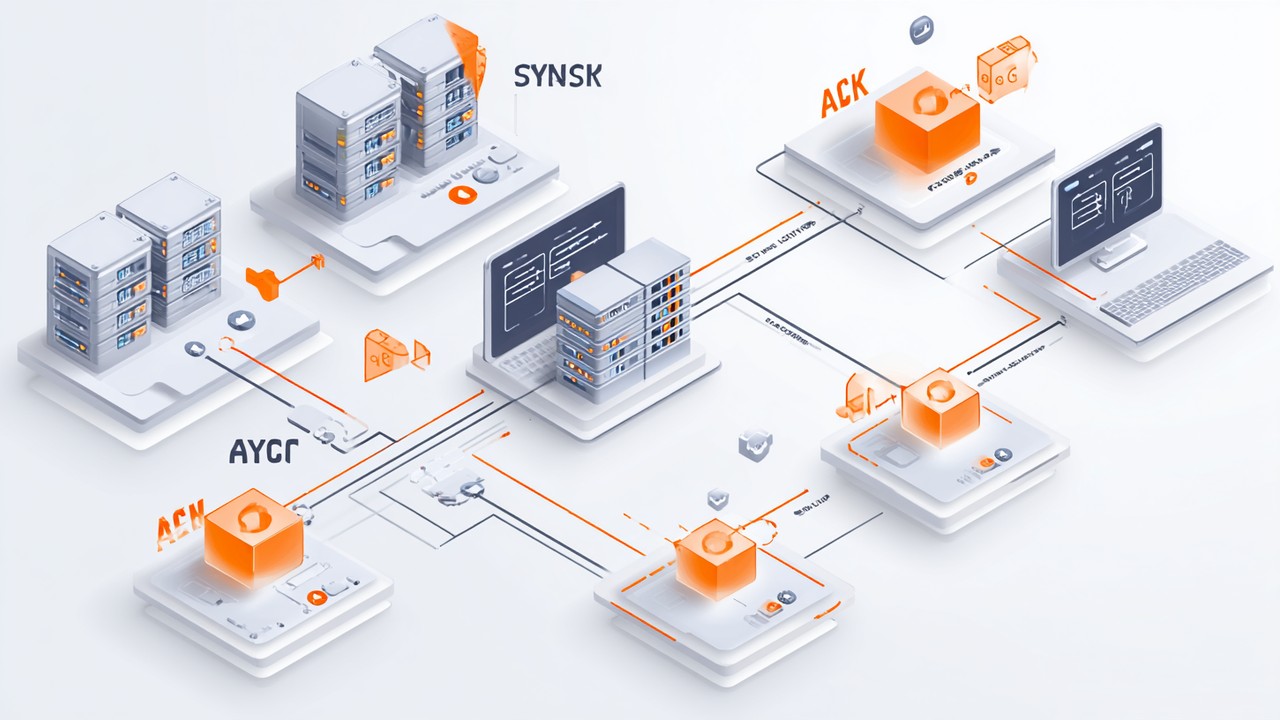TCP Slow Start: Connection Initialization Impact on TTFB
TCP connections form the backbone of modern internet communication, enabling reliable data transfer across vast networks. One critical mechanism that governs the efficiency of these connections, especially during their initialization, is the TCP Slow Start algorithm. Understanding how Slow Start operates and its influence on the Time to First Byte (TTFB) can reveal key insights into network performance and user experience.
Understanding TCP Slow Start and Its Role in Connection Initialization
TCP Slow Start is a fundamental congestion control algorithm designed to manage data flow during the initial phase of a TCP connection. When two endpoints establish a connection, they must carefully gauge the network's capacity to avoid overwhelming it with excessive data. Slow Start achieves this by controlling the growth of the congestion window (cwnd), which determines how many bytes can be sent before waiting for an acknowledgment.
At the start of a connection, the congestion window is set to a small value, often referred to as the initial congestion window (IW). This conservative approach ensures that the sender does not flood the network immediately. Instead, the congestion window increases exponentially with each round-trip time (RTT) as acknowledgments arrive, probing the network for available bandwidth without causing congestion.
The slow start threshold (ssthresh) acts as a boundary between the Slow Start phase and the next congestion control phase, often called congestion avoidance. Once the congestion window size exceeds the ssthresh, the growth changes from exponential to linear, marking a more cautious approach to bandwidth usage.
Connection initialization is a critical step in TCP communication because it sets the pace for data transmission. The Slow Start algorithm directly impacts this phase by determining how quickly the congestion window expands, which in turn affects the rate at which data packets flow through the network. If the congestion window grows too slowly, it can delay data delivery; if it grows too quickly, it risks causing packet loss and retransmissions.
The interplay between these parameters—cwnd, RTT, IW, and ssthresh—shapes the connection's initial behavior. An optimal balance ensures efficient bandwidth utilization without triggering congestion, thus maintaining a smooth and stable connection. Conversely, suboptimal settings can hinder performance and increase latency.

TCP Slow Start is not just a technical detail but a pivotal factor influencing overall connection performance. By methodically increasing transmission rates, it helps maintain network stability while adapting to varying conditions. This careful balance forms the foundation for reliable and efficient data exchanges that users expect from modern internet services.
Understanding the mechanics of TCP Slow Start allows network engineers and developers to better appreciate how initial connection behavior impacts broader performance metrics. It also opens the door to targeted optimizations that can improve responsiveness and reduce delays, particularly in high-traffic or high-latency environments.
In essence, TCP Slow Start governs the delicate dance of connection initialization, probing the network cautiously to find the optimal transmission rate. This process is crucial for achieving robust and efficient communication, setting the stage for the subsequent data transfer phases that define the user experience.
How TCP Slow Start Influences Time to First Byte (TTFB) in Network Communications
Time to First Byte (TTFB) is a crucial metric in assessing network and web performance, measuring the delay between a client’s request and the arrival of the first byte of the response from the server. This latency directly affects user perception of speed and responsiveness, making TTFB a key focus for optimization in web technologies and network management.
TTFB comprises several stages: the DNS lookup, TCP handshake, TLS negotiation (if applicable), and finally, the actual data transfer from the server. TCP Slow Start fits squarely into the phase after the TCP handshake, where the connection begins transmitting data packets. During this phase, the congestion window starts small and grows exponentially, but this ramp-up inherently introduces a delay in how quickly data can be sent.
The slow ramp-up characteristic of TCP Slow Start means that the sender initially transmits only a limited amount of data, waiting for acknowledgments to increase the congestion window before sending more. This cautious approach protects the network from congestion but can delay the delivery of the very first byte. Until the congestion window grows sufficiently, the sender cannot fully utilize the available bandwidth, resulting in a longer TTFB.
Consider a network environment with high latency or large RTT. In such cases, the acknowledgments that allow cwnd to increase take longer to return to the sender, extending the Slow Start phase. This delay compounds the time before the first byte reaches the client. Similarly, in networks experiencing packet loss, retransmissions triggered by dropped packets cause the congestion window to reset or shrink, prolonging Slow Start and further increasing TTFB.
To illustrate, imagine two scenarios: one with a low-latency, stable network, and another with high latency and intermittent packet loss. In the first scenario, TCP Slow Start quickly scales the congestion window, enabling rapid data delivery and a minimal TTFB. In contrast, the second scenario suffers from slower cwnd growth and frequent retransmissions, significantly delaying the first byte's arrival.
The TCP handshake, consisting of the SYN, SYN-ACK, and ACK packets, establishes the connection but does not transmit data payloads. Once complete, Slow Start governs how quickly data begins flowing. The handshake itself adds baseline latency, but the subsequent Slow Start phase can dominate TTFB, especially on networks with challenging conditions.
Visualizing this timeline:
- Client sends SYN
- Server responds with SYN-ACK
- Client sends ACK (handshake complete)
- Sender transmits initial data limited by IW
- Congestion window grows exponentially as ACKs arrive
- First byte arrives at the client once sufficient data is sent

In this sequence, the period from step 4 to step 6 is where Slow Start exerts its influence on TTFB. Faster cwnd growth leads to quicker data transmission and a lower TTFB, whereas slower growth results in noticeable delays.
Understanding the relationship between TCP Slow Start and TTFB is essential for optimizing network performance, especially for web applications where milliseconds matter. By recognizing that Slow Start’s cautious probing can introduce initial delays, engineers can explore tuning parameters and novel congestion control algorithms to minimize TTFB and enhance user experience.
In summary, TCP Slow Start directly impacts TTFB by controlling the initial data transmission rate after the handshake. Its exponential growth nature, while protecting network stability, can increase the time before the first byte reaches the client, particularly under adverse network conditions. Balancing this trade-off is key to achieving both reliability and responsiveness in network communications.
Factors Affecting TCP Slow Start Behavior and Their Impact on TTFB
The performance of TCP Slow Start is highly sensitive to various network and system factors, each influencing how quickly the congestion window grows and, consequently, how swiftly the first byte reaches the client. Understanding these factors is essential to diagnosing delays in TTFB and identifying opportunities for optimization.
Network Conditions Influencing Slow Start Duration and Efficiency
Latency and RTT Variations:
The round-trip time (RTT) fundamentally governs the speed at which acknowledgments return to the sender, allowing the congestion window to expand. Networks with high latency experience longer RTTs, which in turn slow the exponential growth of cwnd during Slow Start. This longer feedback loop can significantly increase TTFB, especially for connections spanning long distances or traversing multiple hops.Packet Loss and Retransmissions:
Packet loss is detrimental during Slow Start because it signals potential congestion, prompting TCP to reduce the congestion window drastically. This reduction, often resetting cwnd to the initial congestion window size or less, effectively restarts the Slow Start phase. The need to retransmit lost packets further delays data delivery, increasing TTFB and reducing throughput.Initial Congestion Window Size (IW) Configurations:
The size of the initial congestion window is a critical tuning parameter. A larger IW allows more data to be sent before waiting for acknowledgments, potentially reducing TTFB by accelerating the initial data flow. However, an oversized IW risks causing packet loss if the network cannot handle the burst, triggering retransmissions and longer delays. Modern TCP implementations often use an IW of 10 segments, balancing aggressive transmission with network safety.Slow Start Threshold Adjustments:
The slow start threshold (ssthresh) defines when TCP transitions from exponential growth to linear growth in congestion avoidance. A carefully set ssthresh helps maintain a stable connection by avoiding abrupt congestion. Improper ssthresh values may cause premature transition or prolonged Slow Start, each affecting TTFB differently depending on network conditions.
Server and Client TCP Stack Implementations and Tuning Parameters
The behavior of Slow Start can vary based on how different operating systems and network stacks implement TCP congestion control. Some TCP stacks offer tunable parameters allowing network administrators to adjust IW, ssthresh, and retransmission timers to better fit specific workloads or network environments. Servers with optimized TCP stacks can reduce the Slow Start duration, positively impacting TTFB by enabling faster initial data transmission.
Moreover, client devices with modern TCP implementations may support advanced features that influence Slow Start dynamics. For instance, mobile devices operating on variable wireless networks may experience frequent fluctuations in RTT and packet loss, requiring adaptive tuning to maintain efficient Slow Start performance.
Impact of Modern TCP Enhancements on Slow Start and TTFB
Recent advancements in TCP congestion control have introduced algorithms and features designed to mitigate Slow Start’s impact on TTFB:
TCP Fast Open (TFO):
This extension reduces the latency of connection establishment by allowing data to be sent during the TCP handshake phase. By overlapping the Slow Start initiation with connection setup, TFO can shorten the effective TTFB, improving responsiveness.TCP BBR (Bottleneck Bandwidth and RTT):
Unlike traditional loss-based algorithms, BBR estimates available bandwidth and RTT to pace transmissions more intelligently. This proactive approach allows faster ramp-up without waiting for packet loss signals, often resulting in lower TTFB and more efficient network utilization.
Effect of Network Intermediaries on Slow Start Performance
Network middleboxes such as proxies, content delivery networks (CDNs), and firewalls can also influence Slow Start behavior:
Proxies and CDNs:
By caching content closer to the user, CDNs reduce RTT and packet loss likelihood, indirectly accelerating Slow Start and lowering TTFB. They also facilitate connection reuse, which can bypass Slow Start entirely for subsequent requests.Firewalls and Traffic Shapers:
These devices may impose rate limits, modify TCP parameters, or introduce additional latency. Such interference can disrupt the natural growth of the congestion window, prolonging Slow Start and increasing TTFB.
Collectively, these factors demonstrate that TCP Slow Start does not operate in isolation but is deeply affected by the network path characteristics, endpoint configurations, and modern protocol enhancements. A comprehensive understanding of these influences is crucial for effectively diagnosing and improving TTFB in diverse network environments.
Optimizing TCP Slow Start to Reduce TTFB for Enhanced User Experience
Optimizing TCP Slow Start is a powerful way to reduce the Time to First Byte (TTFB) and deliver a faster, more responsive network experience. Since Slow Start controls the initial data transmission rate, carefully tuning its parameters and leveraging modern technologies can significantly speed up connection initialization and improve overall performance.
Increasing the Initial Congestion Window Size Within Safe Limits
One of the most effective strategies to minimize TTFB involves increasing the initial congestion window (IW) size. Traditionally, IW was set to 1 or 2 segments to avoid overwhelming the network. However, research and practical deployments have demonstrated that increasing IW to around 10 segments can safely accelerate data transmission without causing excessive packet loss in most modern networks.
By allowing more data to be sent immediately after connection establishment, a larger IW reduces the number of RTTs required to deliver the first byte. This change shortens the Slow Start phase and thus decreases TTFB. However, it remains crucial to balance aggression with caution, as an oversized IW on unstable or low-bandwidth networks can lead to congestion and retransmissions, ultimately increasing latency.
Implementing TCP Fast Open to Reduce Handshake Latency
TCP Fast Open (TFO) is a valuable enhancement designed to reduce the latency involved in connection setup and Slow Start. TFO enables the client to send data during the initial TCP handshake (SYN packet), eliminating the need to wait for handshake completion before transmitting application data.
This overlapping of the handshake and data transfer phases effectively reduces the time before the first byte is sent, thus lowering TTFB. Many modern operating systems and browsers support TFO, and enabling it in server configurations can yield significant performance gains, especially for short-lived HTTP connections.
Leveraging TCP Pacing and Congestion Control Algorithms Like BBR
Another optimization avenue involves adopting advanced congestion control algorithms such as TCP BBR (Bottleneck Bandwidth and RTT). Unlike traditional loss-based algorithms, BBR estimates the network's available bandwidth and RTT to pace packet transmissions intelligently.
By pacing packets evenly rather than sending bursts, BBR avoids triggering congestion early and allows the congestion window to grow more smoothly and rapidly. This approach reduces packet loss and retransmission events, which are common causes of increased TTFB during Slow Start. Implementing BBR on servers and clients can result in noticeably quicker delivery of the first byte and improved throughput.
Using Persistent Connections and Connection Reuse to Avoid Repeated Slow Starts
Repeatedly performing Slow Start for every new connection adds unnecessary latency to web applications. Utilizing persistent TCP connections (also known as keep-alive connections) allows multiple requests and responses to flow over the same connection without closing it.
By reusing existing connections, applications bypass the Slow Start phase for subsequent requests, dramatically reducing TTFB. This technique is especially effective for HTTP/1.1 and HTTP/2 protocols, where connection reuse is standard practice. Developers should ensure their applications and servers are configured to support and maintain persistent connections for maximum benefit.
Best Practices for Web Servers and Application Developers to Tune TCP Parameters
Web servers and applications can further optimize Slow Start by tuning TCP parameters such as IW, ssthresh, and retransmission timers. Some best practices include:
- Monitoring connection quality and adjusting IW dynamically based on network conditions
- Configuring appropriate ssthresh values to transition smoothly from Slow Start to congestion avoidance
- Employing adaptive retransmission timers to minimize delays caused by packet loss
- Enabling TCP features like Selective Acknowledgments (SACK) to improve recovery from loss
By actively tuning these parameters, server administrators can tailor TCP behavior to their specific workload and network environment, achieving a better balance between speed and reliability.
Role of Content Delivery Networks (CDNs) and Edge Caching in Mitigating Slow Start Delays
Content Delivery Networks (CDNs) and edge caching play a pivotal role in reducing TTFB by minimizing the physical distance and network hops between users and content sources. By serving content from edge servers located closer to users, CDNs reduce RTT and packet loss, creating favorable conditions for faster Slow Start progression.
Additionally, CDNs often implement connection pooling and keep-alive strategies, further decreasing the frequency of Slow Start events. This combination effectively masks the inherent delays of TCP Slow Start, making web pages and applications feel more responsive.
Case Studies and Performance Benchmarks Demonstrating TTFB Improvements
Real-world benchmarks have consistently shown that optimizing Slow Start parameters and leveraging modern TCP enhancements can significantly improve TTFB. For example:
- Increasing IW from 3 to 10 segments on a busy web server reduced median TTFB by up to 30% under typical network conditions.
- Deploying TCP Fast Open on popular HTTP servers resulted in TTFB reductions of 15-25%, particularly for mobile users on high-latency networks.
- Switching from traditional loss-based congestion control to BBR on cloud servers improved TTFB by up to 20% while maintaining stable throughput.
These results highlight the tangible benefits of actively managing TCP Slow Start to enhance user experience and optimize web performance.
By combining these strategies—parameter tuning, protocol enhancements, persistent connections, and CDN integration—network operators and developers can significantly reduce the impact of TCP Slow Start on TTFB, delivering faster, smoother, and more reliable connections to end users.

Practical Insights on Balancing TCP Slow Start Parameters for Optimal Connection Initialization and TTFB
Achieving the right balance in tuning TCP Slow Start parameters requires understanding the trade-offs between aggressive bandwidth utilization and network stability. Overly cautious Slow Start settings can lead to unnecessarily long TTFB, while overly aggressive configurations risk congestion and packet loss.
Guidelines for Selecting Initial Congestion Window Sizes
Selecting an appropriate initial congestion window (IW) depends on typical network conditions such as RTT and available bandwidth:
- For low-latency, high-bandwidth networks, a larger IW (8-10 segments) is generally safe and beneficial.
- On networks with high RTT or variable quality, a moderate IW (4-6 segments) can avoid excessive retransmissions.
- In highly constrained or wireless environments, smaller IWs may be necessary to ensure stability.
Dynamic IW adjustment based on observed network metrics can further optimize performance.
Monitoring and Measurement Techniques to Assess Slow Start Impact on TTFB
Continuous monitoring is essential for understanding how Slow Start affects TTFB in production environments. Techniques include:
- Analyzing packet captures with tools like Wireshark to observe congestion window growth and retransmissions
- Measuring end-to-end latency and TTFB using synthetic testing platforms and real user monitoring (RUM)
- Employing TCP-specific metrics such as cwnd size, RTT, and loss rates from server and client TCP stacks
These insights enable informed tuning and troubleshooting.
Tools and Metrics for Diagnosing and Optimizing TCP Slow Start Behavior
Network engineers and developers can leverage various tools to diagnose and optimize Slow Start:
- Tcpdump and Wireshark: For detailed packet-level analysis
- iperf and netperf: For testing throughput and latency under controlled conditions
- Linux TCP stack statistics (/proc/net/tcp, sysctl): For real-time parameter tuning
- Performance monitoring platforms: To correlate TTFB with network events
Utilizing these resources helps identify bottlenecks and optimize TCP Slow Start behavior effectively, ultimately leading to improved TTFB and enhanced user experience.
